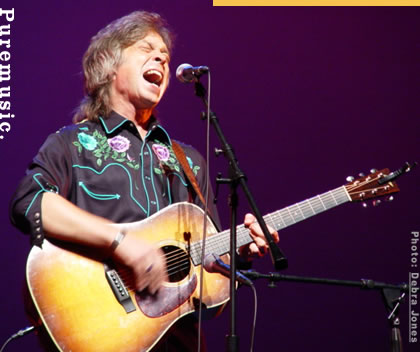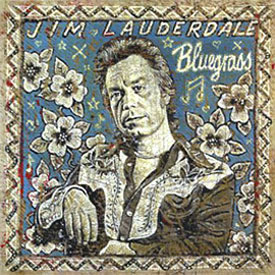
A Conversation with
Jim Lauderdale
(continued)
PM: Even though you get a lot of cuts, you write so many great eccentric songs, too, that I'm curious to know what you're generally thinking when you start a song, what you want out of it, kind of a thing. You know what I mean?
JL: Well, I just want to be able to finish. I start so many things, and it's easy for me just to come out with a melody, but the challenge is for me to finish one.
PM: Right.
JL: And mostly that's if I'm writing alone. But I think I enjoy the process in doing it, because you never know what's going to happen. And I sure enjoy making my own albums. So that's kind of a big test. And then if somebody else--if it's maybe something I'm not sure I want to record, I'll still make a demo. But you never know, it's really out of your control if somebody else might want to record it someday. You can just do your best, as far as if you think you've accomplished writing something you like.
PM: Right. You're just trying to finish a song, trying to make it a song you like and what happens after that is just in somebody else's hands.
JL: Yeah.
PM: Yeah. It makes sense to me. There are a couple three songs on these two discs that have those one note melodies, like "Cautious" or "Single Standard Time."
JL: Uh-huh.
PM: That's almost like a Lauderdalian move, now, a signature move.
JL: Hmm.
PM: I mean, you write so many great melodies it really sticks out when you do that [singing] "dayer, dayer, dayer, dayer, dayer," thing.
JL: Uh-huh.
PM: [laughs] And is that purposeful when you do that? Like almost a monotonal melody?
JL: Well, it just kind of happens. I mean, it's not something I even really think about. When I get a melody, it just kind of comes to me. I know that sounds kind of corny or something, but that's really the way it happens. They just kind of come. They're sometimes complete things. But that's kind of the fun part of it.
PM: Yeah, you just let it happen.
JL: Yeah.
PM: That's a great Jon Langford illustration on the cover.
JL: Oh, man, I've been wanting to work with him for a long time. And I really feel fortunate and honored that he agreed to work with me. He did such a good job.
PM: Really! I mean, it's Rushmore-like. It's fantastic.
JL: Yeah.
PM: How did that collaboration, if you'd call it that, come about?
JL: Well, Ollie O'Shea, an old friend of mine who plays [fiddle] in my bluegrass band, set it up through John Rice. This fellow named John Rice in Chicago is a really great picker, and he's done some work with Jon Langford musically. Because Jon does really great music on his own, as you probably know.
PM: Oh, yeah, a great musician as well.
JL: Yeah. So anyway, so I tracked him down through John Rice, and just proposed it to him. And luckily, he agreed. And Ollie was the one, too, that had kind of prodded me to work with Odie.
PM: Really?
JL: Yeah. So I'm real grateful for that.
PM: Well, there are two good solids on Ollie's tab, there.
JL: Yeah, yeah. That's right.
PM: Odie and Langford.
JL: Yeah.
PM: So you mentioned a couple of Gary Allan cuts, and also a Lee Ann Womack cut that's in the works.
JL: Yeah.
PM: You popping any other good cuts lately? Has it be a good year for that?
JL: I think that's it for right now. But hey, I'll take that.
PM: Absolutely. continue
print (pdf) listen to clips puremusic home
